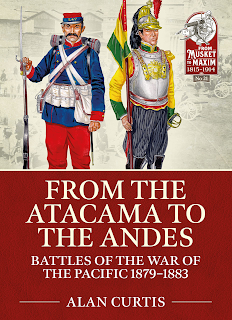With Helion constantly searching about for books to publish paper covered, Alan has taken the opportunity to revisit the subject with his latest research (by the way, it was Alan who wrote the uniforms section for "It's Getting a Bit Chile" and got Outpost to make their 15mm range of figures) and get something that looks a bit more professional out there.
And the production standards are indeed a massive step up. It incudes colour plates for uniforms and colour maps and has a lot of black and white photographs supplementing the text.
Without comparing them side by side on my initial read through it looks to me that Alan has compiled a lot more details and information. There's very little wasted space in the book, with each paragraph packed with information. It has good detail on the various armies at each stage of the campaign with excellent OOBs. The descriptions of the battles and campaigns are thorough and well written. It has been a worthy addition to my library.
But...as is so often the case with Helion it isn't quite as good as it could have been. It is blessedly short on typos - I noticed one, and that was punctuation - but it has no index. I've given up expecting these, however there's an issue that is really irritating.
Initially I really liked the redrawn maps of the battles. They're in colour and those in "To the Last Cartridge" are in b&w and really confusing with the thick contour lines. Then I started to realise as I read through the book that all the artist had done was take the original maps and just redrawn them more clearly and in colour. Then it all got a bit frustrating. The maps had labels not referred to in the text and in one case at least the key from the original map seems to have been lost. Now the maps are much bigger it should have been possible to provide a key for each with unit names, rather than just labelling a whole area as "1st Div". Added to that not all of the place names in the text are on the maps. What use is it writing that unit X moved up to place Y if the unit and the place aren't labelled on the map? Also, all the original campaign maps are missing completely. Unless you know where all the major towns and cities of Peru, Chile & Bolivia are together with the names of regions whole pages of text are of limited value in enabling you to understand exactly what is going on. I don't know why all the campaign maps from "TTLC" were not redrawn and added to the book. It might be a budgetary issue, or something else, but it's a major failing in a book of over 200 pages (the Osprey has suitable campaign maps, but deficient in other areas and does not really compare to this). I would have dropped some of the colour illustrations of various soldiers and had the campaign maps instead. After all, they aren't the greatest drawings in the world, I'm afraid, and don't give you much more than what's contained in the uniforms appendix if you want to paint an army.
It is frustrating. I'm glad I bought the book, but what is wrong with it wouldn't have been hard to fix so it is a 4* review from me, not a 5*. Hopefully, however, it will bring the original Pacific War to wider attention and increase sales of IGABC.
Well, I can dream.

Text that does not correspond to the accompanying maps or vice versa is a pet peeve of mine too. With these flaws pointed out and the difficulty in following the action, I am surprised that you give this a 4* rating. This level of confusion would likely see a low result from me. Still, for a period not easily accessible, I suppose, beggars can't be choosers.
ReplyDeleteThe text is the most important component and it is very good. I have other books with the maps in.
DeleteTrebian,
ReplyDeleteI took the plunge and ordered a copy.
All the best,
Bob
I think it is a book worth owning. It is a shame that slightly more care was not spent on the publication.
DeleteHmmm, the ongoing issue with Helion not wishing to pay circe £500 for an editor/proof reader has raised it's head again. A real shame as so many of their books have been spoilt IMHO by no going down this road.
ReplyDeleteThey have clearly made a decision about where to spend money. They have created an environment where these shortcomings are accepted as the price for getting books to market that would otherwise possibly not make it. Their business model seems to be to produce a high volume of publications regardless of quality. They also do very little promotion of individual titles.
Delete